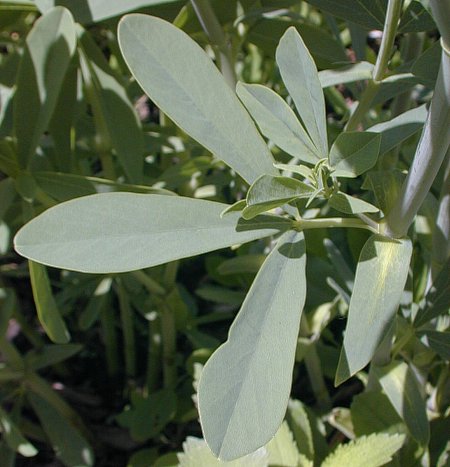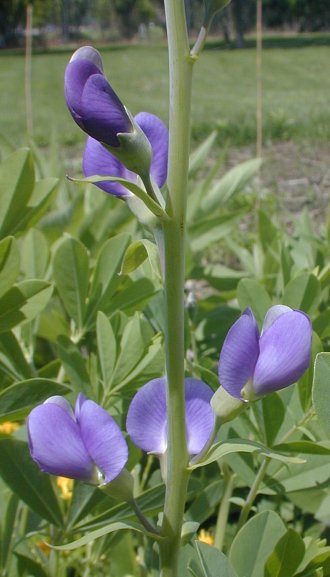Description: This herbaceous perennial plant sends up one or more leafy stems (usually several) that branch abundantly, forming a bushy appearance. The stems are light green or whitish green, terete, glabrous, and sometimes glaucous. Alternate trifoliate leaves occur along the entire length of each stem, changing little in size. Their leaflets are ¾–1½" long and about one-half to one-third as much across; they are oblanceolate to obovate in shape and entire (toothless) along their margins. The leaflet bottoms are wedge-shaped (cuneate), while their tips are more rounded and blunt. The upper and lower leaflet surfaces are grayish green, medium green, or bluish green; they are glabrous. The leaflets have prominent central veins; their surfaces are more or less inclined (angled upward) along both sides of these veins. The leaflets are sessile or nearly so. The petioles of the trifoliate leaves are up to ½" long; they are light green and glabrous. At the bases of petioles, there are pairs of leafy stipules. Individual stipules are up to ¾" long, although they are typically about ¼" long. The stipules are linear-lanceolate to oblong-lanceolate in shape and entire along their margins. The upper stems terminate in erect racemes of flowers about ½–1½' long; the flowers are moderately distributed along these racemes. The central stalks of these racemes are light green or whitish green, terete, glabrous, and sometimes glaucous. Each flower is about 1" long, consisting of a tubular calyx with 4-5 short teeth, a corolla consisting of 5 petals, 10 stamens, and a pistil with a single style. The calyx is light green or grayish green and glabrous; it is shorter than the corolla. The corolla is pale blue to dark blue; it has a typical pea-like floral structure, consisting of an upright banner and a pair of forward-projecting wings that enclose a keel containing the reproductive organs. The slender pedicels of the flowers are up to ½" long and ascending; at the bases of these pedicels, there are solitary leafy bracts up to 1¼" long that are linear-lanceolate in shape and early-deciduous. The blooming period occurs during mid- to late spring for about 3 weeks. There is no noticeable floral scent.

Afterwards,
fertile flowers are replaced by inflated glabrous
seedpods that become up to 2½" long and ¾" across. These seedpods are
short-oblongoid in shape with slender beaked tips. Immature seedpods
are light
green or grayish green, but they become black at maturity, when they
split in two to
release their seeds. Each healthy seedpod contains 25-50 seeds,
although fewer seeds may occur because of predation or adverse weather
conditions. Individual seeds are 2–2.5 mm. long, kidney-shaped
(reniform), and light to dark brown. The root system consists of a
branching taproot
that often forms clonal offsets.
Cultivation:
The
preference is full sun, mesic to dry conditions, and a slightly
acidic soil that is gravelly or rocky.
Blue Wild Indigo readily adapts to fertile loamy soil in gardens, but
in naturalistic settings it may have difficulty competing with other
plants. Blue Wild Indigo is somewhat slow in becoming established, but
it is not difficult to cultivate. Once this plant becomes established,
it is very tolerant of drought and long-lived. Like many other legumes,
its root system binds nitrogen to the soil via symbiotic bacteria.
Range & Habitat:
Blue Wild Indigo may be native to NE Illinois in the Chicago area, or
it could be a horticultural escape (see Distribution
Map).
In either case, this plant is extremely rare, and
perhaps extirpated from the state as wild populations have not been
observed in many years. The primary range of Blue Wild Indigo extends
northward
to the Ohio River, although isolated populations of this plant have
been found further to the north in several states. A dwarf variety of
this species also occurs further to the west. Habitats include
rocky open woodlands, gravel prairies, and rocky banks
of rivers. Occasional wildfires are probably beneficial in maintaining
populations of this plant by reducing competition from woody vegetation

Faunal Associations: Queen bumblebees are the primary pollinators of the flowers, where they feed on nectar primarily. Other insects feed destructively on the leaves, developing seeds, and other parts of Blue Wild Indigo and other Wild Indigos (Baptisia spp.). These species include larvae of two moths, the Three-lined Grapholita (Grapholita tristrigana) and Black-rimmed Prominent (Dasylophia anguina), larvae of two skippers, the Wild Indigo Duskywing (Erynnis baptisiae) and Hoary Edge (Achalarus lyciades), and larvae of three butterflies, the Frosted Elfin (Callophrys irus), Marine Blue (Leptotes marina), and Orange Sulfur (Colias eurytheme); see Miller (1987), Covell (1984/2005), Bouseman et al. (2006), and Bouseman & Sternburg (2001). Other insect feeders include the Wild Indigo Weevil (Apion rostrum) and another weevil (Tychius sordidus). The larvae of these weevils feed on the developing seeds, while the adults feed on the leaves and flowers. The Ash-Gray Blister Beetle (Epicauta fabricii) feeds on the flowers and young seed pods, while two leaf beetles, Pachybrachis luridus and Pachybrachis trinotatus, feed on the leaves of Wild Indigos. The Lupine Bug (Megalotomus quinquespinosus) and other broad-headed bugs (Alydus spp.) feed on the seeds. The thrips, Neohydatothrips baptisiae, also uses these plants as sources of food. See Sauer (2005), Evans et al. (1989), Clark et al. (2004), Schaeffer (1980), and Stannard (1968) for more information. Mammalian herbivores usually avoid the consumption of Blue Wild Indigo and other Wild Indigos because their foliage is somewhat toxic.

Photographic
Location:
The above photographs were taken from the webmaster's wildflower garden
in Urbana, Illinois.
Comments:
This is a favorite garden plant because of its showy flowers and
attractive foliage. There is a dwarf variety of Blue Wild Indigo, Baptisia
australis minor,
that occurs in prairies of the southern and central Great Plains. This
variety is smaller in overall size, but it has slightly larger fragrant
flowers. Sometimes this variety is classified as a distinct species, Baptisia minor.
Both the typical variety and the dwarf variety have
blue flowers. Other Wild Indigos (Baptisia
spp.) can be distinguished
by their differently colored flowers, varying from white to yellow.
There are also some differences in the characteristics of their leaves,
stipules, inflorescences, and growth form, making them fairly easy to
differentiate. Lupines (Lupinus
spp.) can be distinguished from Wild
Indigos by the greater number of leaflets (more than 3) in their
palmately compound leaves. Another interesting difference is the lack
of nectaries in the flowers of lupines.